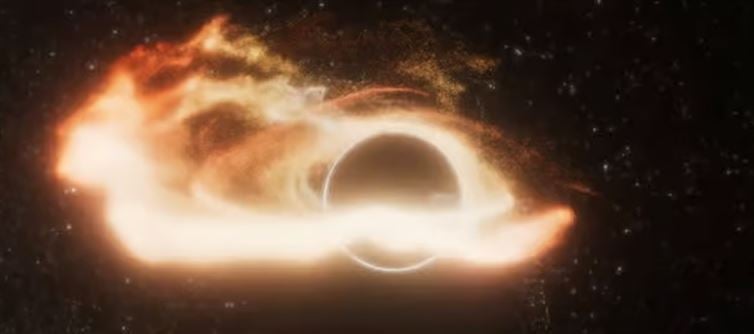
“The Black Hole That Shouldn’t Exist: Astronomers Stunned as Cosmic Monster Feeds Where No Galaxy Should”
A rogue supermassive black hole tears a star apart thousands of light-years from its home — rewriting everything we thought we knew about the universe.
A Cosmic Crime Scene — And the Culprit Is Missing
It began like a whisper in the night sky — a sudden, blazing flare caught by the Zwicky Transient Facility, a telescope system trained to catch fleeting cosmic events. At first, it looked like a routine stellar death, one of countless across the universe.
But this wasn’t just any dying star.
This was a cosmic execution — a black hole feasting on a sun-sized victim thousands of light-years from where such a monster should even exist.
Astronomers are calling it AT2024tvd, a tidal disruption event — when a star strays too close to a black hole, gets torn apart, and is turned into glowing plasma. Normally, these brutal displays happen in galactic hearts, the cosmic downtowns where black holes reside.
This one? It’s happening 2,600 light-years off-center. In galactic terms, that’s like finding a lion hunting in the middle of the ocean.
The Cosmic Blender From Hell
When a black hole shreds a star, it’s not quiet. The star stretches into a stream of gas, swirls at near-light speed, heats up to millions of degrees, and releases light brighter than entire galaxies for weeks or months.
But this one — AT2024tvd — is rewriting the playbook. Not only is it happening in deep intergalactic suburbia, but it’s also erupting faster and fiercer than any tidal disruption event astronomers have ever recorded.
“It’s truly extraordinary,” says Itai Sfaradi, postdoctoral researcher at UC Berkeley, who led the radio observations. “We’ve never seen such bright radio emission from a tidal disruption event happening away from a galaxy’s center — and it’s evolving faster than anything before.”
The question haunting astrophysicists now: how did a supermassive black hole end up so far from home?
The Runaway Monster Theory
One theory suggests the black hole was flung from its galaxy’s core — perhaps ejected during a violent galactic merger, when two supermassive black holes collided and one got the cosmic boot.
Another possibility?
It’s an intergalactic drifter, a relic of a dead or cannibalized galaxy, silently roaming space until an unlucky star wandered too close.
If that’s true, this discovery could confirm a long-held suspicion among astronomers — that rogue supermassive black holes wander the universe, invisible until the moment they feed.
They are the cosmic ghosts, haunting the edges of galaxies, waiting centuries — even millennia — for their next meal.
Double Trouble: Two Bursts, One Mystery
As if one act of destruction wasn’t enough, the black hole fired off two massive radio bursts — one 131 days after the initial flare, and another even stronger 63 days later.
This strange double outburst has baffled scientists. The best theory so far? The black hole’s “backwash” — shockwaves from the feeding frenzy — slammed into surrounding gas and debris, igniting new waves of radiation.
It’s a cosmic aftershock, like thunder rolling through the void after a celestial explosion.
Rewriting the Black Hole Rulebook
This discovery, published in The Astrophysical Journal Letters, could mark a paradigm shift. For decades, astronomers believed supermassive black holes lived and fed exclusively in galactic centers.
Now, that rulebook is in ashes.
If AT2024tvd is what scientists think it is — a rogue supermassive black hole actively devouring a star far from its galaxy’s core — then our universe might be littered with invisible predators.
Each one is silent. Each one is waiting.
⚫ The Bottom Line:
The cosmos just blinked — and revealed a monster in the dark.
A black hole without a home, rewriting the laws of galaxies.




 click and follow Indiaherald WhatsApp channel
click and follow Indiaherald WhatsApp channel